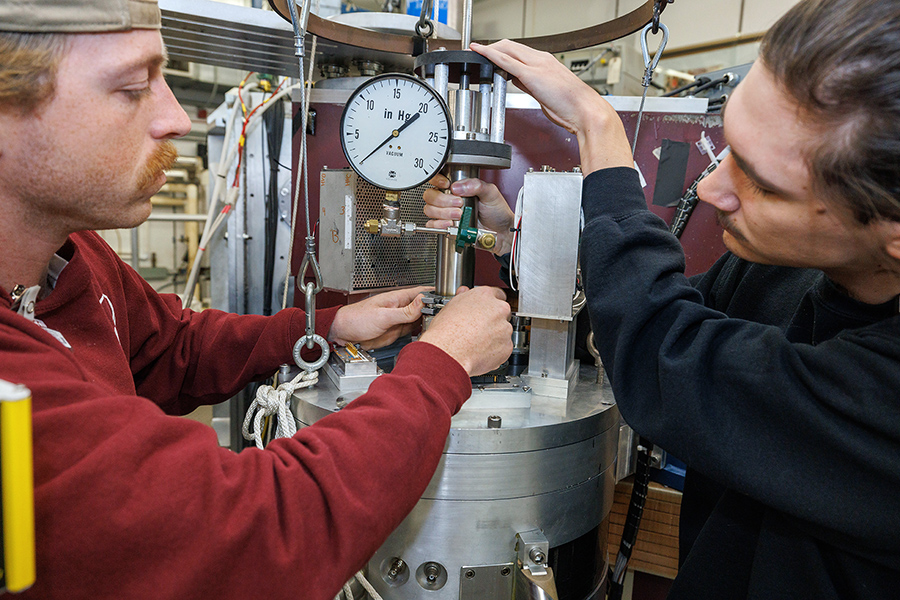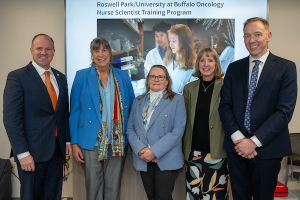Advances in automated materials design and analysis are accelerating the discovery of useful materials — especially in combination with artificial intelligence, says Charles Schroeder, the James Economy Professor in materials science and engineering and a professor in chemical and biomolecular engineering at the University of Illinois Urbana-Champaign.
Soon, Schroeder and his colleagues will spin the dial faster — and try more combinations — than ever.
The University of Illinois has received a $3.6 million Major Research Instrumentation grant from the National Science Foundation to acquire a fully automated system for designing and analyzing polymers. Capable of mixing materials, analyzing their properties, and maintaining a digital database, the system will accelerate ongoing and future efforts to develop energy-efficient manufacturing methods and produce sustainable plastics.
“To our knowledge, this is a unique instrument in academia. We are not aware of another that exists at a university in the United States,” said Schroeder, the project leader and a researcher at the Beckman Institute for Advanced Science and Technology, where the three-year installation process is set to begin in November 2023.
The system consists of four large modules, each about the size and shape of a freestanding walk-in closet. Its design team is led by co-PI Daniel Krogstad, a senior research scientist at the Illinois Applied Research Institute and a research assistant professor in materials science and engineering.
The process begins when researchers load a selection of starter materials into the first module. These so-called ingredients can be solid, liquid, or a honey-like consistency — referred to as viscous — that exists between the two, and they are stored individually inside the module. From these materials, investigators can order project-specific solutions, which the machine dispenses into test tubes and transfers to the mixers via robotic arm.
With the test tubes filled and mixed, the samples advance to the subsequent modules for characterization to identify their properties. One module will gauge how samples respond to temperature (thermal properties), another will measure whether the materials flow more like water or molasses (rheological properties), and still another is fully customizable for project-specific characterizations like optical imaging. Additional modules may be added in the future as research interests ebb and flow.
More than just a physical taskmaster, the system will also include sophisticated software to match the details of each solution to an accurate description of its properties, making results more reliable and experiments more repeatable. Researchers aided by automation can create at least 50 times the number of samples — or sequences on the chemical combination lock — than would be feasible with human hands alone. The instrument can also run 24 hours a day for long periods of time with minimal human intervention.
Once the data are recorded, researchers can use artificial intelligence or machine learning methods to pan the data for nuggets of insight.
“When you have these large datasets, artificial intelligence helps to tease out nonobvious correlations — the ones that appear to be subtle but are actually very important,” Schroeder said.
Subtle correlations often lead to big discoveries, as evidenced by the cross-campus collaborators eager to use the new tool.
One such project led by Krogstad will use the digital database to fine-tune the materials used for additive manufacturing, or the so-called ink in a 3D printer. With AI, Krogstad can meticulously edit the ink-making process with a level of detail that would not have been feasible before, “like testing out a new cake recipe,” he said.
“We know that the ingredients, the mixtures, and the processing all matter. There’s the mixing component. Is there an ideal sequence? There’s the temperature component. Are you baking at 400 degrees or 450 degrees, and for how long? And there is the consistency component. How thick should the batter be?
“In the context of additive manufacturing, all of these properties are important, and the new system will allow us to quickly and efficiently navigate these large variable spaces to develop optimal materials,” he said.
Another polymer-focused project stems from a new Energy Frontier Research Center housed by The Grainger College of Engineering and the Beckman Institute. Researchers at the center study thermoset polymers, which are ideal for designing aircraft, drones, and wind turbines, but require large quantities of energy to manufacture and cannot be easily melted down and recycled. The researchers’ goal is to improve the overall sustainability of these materials: from manufacturing to end-of-life management.
The center, which is made possible by a $10.65 million from the U.S. Department of Energy, is led by Professor Nancy Sottos, a Beckman researcher and a co-PI on the NSF proposal.
“This new equipment is game-changing for accelerating the design and discovery of high-performance resin formulations that can be manufactured with minimal energy and also be chemically deconstructed and upcycled at the end of their service life,” said Sottos, who is also the department head of materials science and engineering, Swanlund Endowed Chair, and a Center for Advanced Study Professor.
The system will also serve as a natural partner to the Molecule Maker Lab, the do-it-yourself “Lego-kit for molecules” located at the Beckman Institute. The systems will function synergistically, with the new system analyzing materials synthesized in the MML.
Including time for proof-of-concept research, design, delivery, and installation, the system is expected to be up and running within two to three years. The results, however, will be well worth the effort.
According to Jennifer Bernhard, the director of the Applied Research Institute and a Donald Biggar Willett Professor of Electrical and Computer Engineering, the results will be well worth the effort.
“The system will be a transformational asset for polymers research at the university,” she said. “[It] will not only accelerate the basic polymers research that is being carried out by several of our faculty, but it will also build on our ability to carry out translational polymers research and development, which will then expand and invigorate both industry and government partnerships.”
Editor’s notes:
Additional information for the award titled “MRI: Track 2: Acquisition of an automated high-throughput system for combinatorial design and development of complex polymer systems” is available online at https://www.nsf.gov/awardsearch/showAward?AWD_ID=2320276&HistoricalAwards=false.
Additional investigators include Beckman Institute researchers Jeff Baur, the Founder Professor of aerospace engineering and an affiliate professor of materials science and engineering; Paul Braun, the W. W. Grainger Chair and a professor of MatSE; Martin Burke, the May and Ving Lee Professor of Chemistry; Ying Diao, an associate professor of chemical and biomolecular engineering; Christopher Evans, an associate professor of MatSE; Randy Ewoldt, a professor of mechanical science and engineering and the Kritzer Faculty Scholar; Damien Guironnet, an associate professor of ChBE; Nick Jackson, an assistant professor of chemistry; Kathryn Matlack, an assistant professor of MechSE; Jeff Moore, the Stanley O. Ikenberry Research Professor of Chemistry and professor emeritus; Simon Rogers, an associate professor of ChBE; Charles Sing, an associate professor of ChBE; Antonia Statt, an assistant professor of MatSE; and Sameh Tawfick, associate professor of MechSE.
Collaborators within the Applied Research Institute include Eliezer Colina Morles, a senior research engineer; Ngoc Nguyen, a staff research scientist; and Michal Ondrejcek, a senior software engineer.
Reach Charles Schroeder at [email protected]
Media contact: Jenna Kurtzweil, [email protected]



